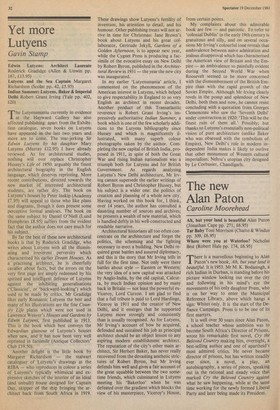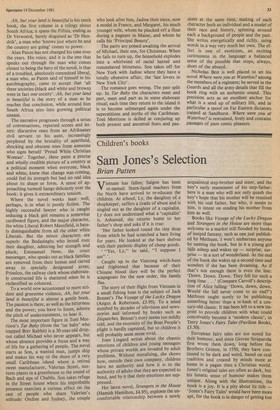The new Alan Paton
Caroline Moorehead
Ah, but your land is beautiful Alan Paton (Jonathan Cape pp. 271, £6.95) Tar Baby Toni Morrison (Chatto & Windus pp. 309, £6.95) Where were you at Waterloo? Nicholas Best (Robert Hale pp. 174, £6.95) There is a marvellous beginning to Alan 1 Paton's new book, Ah, but your land is beautiful. It is 1953. Mr M. K. Bodasingh, a rich Indian in Durban, is standing before his picture window looking out over the city and following in his mind's eye the movements of his only daughter Prem, who is on her way to enter the Municipal Reference Library, above which hangs a sign: Whites only. It is the start of the Defiance Campaign. Prem is to be one of its first martyrs.
It is well over 30 years since Alan Paton, a school teacher whose ambition was to become South Africa's Director of Prisons, wrote his remarkable first novel, Cry the Beloved Country making him, overnight, a best-selling author and one of apartheid's most admired critics. He never became director of prisons, but has written steadily ever since, a novel, a play, an autobiography, a series of pieces, speaking out in the rational and steady voice that marked Cry the Beloved Country against what he saw happening, while at the same time working for the newly formed Liberal Party and later being made its President. Ah, but your land is beautiful is his tenth book, the first volume in a trilogy about South Africa; it spans the Fifties, ending as Dr Verwoerd, barely disguised as 'Dr Hendrik', a man who 'knows just where he and the country are going' comes to power.
Alan Paton has not changed his tone over the years. His voice, and it is the one that speaks out through the man who comes closest to being the hero of the novel, is that of a troubled, absolutely committed liberal, a man who, as Paton said of himself in his autobiography, came to accept that 'all these societies (black and white and brown) were in fact one society'. Ah, but your land is beautiful is the story of a man as he reaches that conclusion, while around him South Africa stirs into growing political unease.
The narrative progresses through a series of conversations, reported scenes and let ters: discursive ones from an Afrikaaner civil servant to his aunt, increasingly perplexed by the brutality of apartheid, shocking and obscene ones from someone who signs herself 'Proud White Christian Woman'. Together, these paint a precise and wholly credible picture of a country at a political moment when everyone, black and white, knew that change was coming, could feel its strength but had no real idea about its shape or form. A sense of ap proaching turmoil hangs delicately over the book: it gives it extraordinary tension.
Where the novel works least well, perhaps, is in what is purely fiction. The highly successful lawyer who is caught seducing a black girl remains a somewhat cardboard figure, and the major character, the white Liberal Robert Mansfield, is barely distinguishable from all the other white Liberals. But the minor characters are superb: the Bodasinghs who brood over their daughter, admiring her strength and pluck; Emmanuel Nene, the court messenger, who speaks out as black families are removed from their homes and carted away to specially designated areas; Prinsloo, the railway clerk whose elaborately constructed life is shattered when he is reclassified as coloured.
To a world now accustomed to more strident and gruesome violence, Ah, but your land is beautiful is almost a gentle book. The passion is there, as well as the bitterness and the power; you have to listen, admire the pitch of understatement, to hear it.
The most important figure in Toni Morrison's Tar Baby (from the 'tar baby' who trapped Brer Rabbit) is a 30-year-old dropout called Michael who never appears, but whose absence provides a focus and a way of life for a gathering of people. The novel starts as Son, a wanted man, jumps ship and makes his way to the shore of a very small Caribbean island where a retired sweet manufacturer, Valerian Street, nurtures plants in a greenhouse to the sound of Bach and sips of Chablis. Son takes refuge in the Street house where his improbable presence exercises a curious effect on the cast of people who share Valerian's solitude: Ondine and Sydney, the couple who look after him, Jadine their niece, now a model in France, and Margaret, his much younger wife, whom he plucked off a float during a pageant in Maine, and whom he calls his 'Principal Beauty'.
The party are poised awaiting the arrival of Michael, their son, for Christmas. When he fails to turn up, the household explodes into a whirlwind of racial hatred and remembered bitterness. Son takes off for New York with Jadine where they have a totally obsessive affair, the 'last lovers in New York City'.
The romance goes wrong. The pair split up. In Tar Baby the characters meet and part, meet and part as in some elaborate ritual; each time they return to the island it is to become submerged again under the superstitions and myths of the Caribbean. Toni Morrison is skilled at conjuring up both present and ancestral fears and pas sions at the same time, making of each character both an individual and a model of their race and history, spinning around each a background of people and the past. She writes energetically and richly, using words in a way very much her own. The effect is one of exoticism, an exciting curiousness in the language a balanced sense of the possible that stops, always, short of the absurd.
Nicholas Best is well placed to set his novel Where were you at Waterloo? among the members of a regiment; he served in the Guards and all the army details that fill the book ring with an authentic sound. This precision acts as an excellent anchor for what is a send up of military life, and in particular a spoof on Far Eastern dictators trained at Sandhurst. Where were you at Waterloo? is restrained, lively and contains passages of pure comic pleasure.



































































 Previous page
Previous page